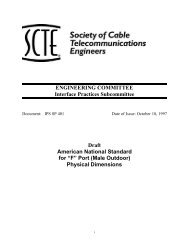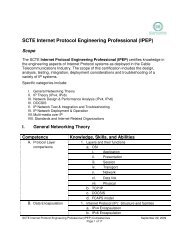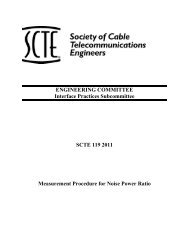SCTE IPS Template, Rev 2
SCTE IPS Template, Rev 2
SCTE IPS Template, Rev 2
- No tags were found...
You also want an ePaper? Increase the reach of your titles
YUMPU automatically turns print PDFs into web optimized ePapers that Google loves.
The first result of the dynamic case considered is that there is, in general, no fixed relationshipbetween AM-XMOD of a two-channel system and that of a multi-channel system. To bespecific, one cannot in general measure the AM-XMOD from any pair of channels and use thisresult to calculate the resultant AM-XMOD due to multiple channels. The resultant multichannelcross modulation level depends upon the relative differences of the phases of the thirdorder distortions, and therefore do not necessarily add on a ‘power basis’. Sometimes, aneffective ‘average’ is assumed and the sum is added as “15 log(x)” for practicality, but thiscauses confusion as to whether or not the products add on a ‘voltage’ basis (i.e. 20 log(x) ) or ona ‘power’ basis (i.e. 10 log(x) ).The second result is that, depending upon the phase variation (vs. frequency) of the third orderdistortion characteristic of the device (or amplifier, or system), the inclusion, or the removal of,several synchronously modulated carriers can produce either an improvement in, or adegradation of, the measured AM-XMOD. A corollary to this is, that in the dynamic caseSynchronous Modulation does not necessarily produce the worst possible measured AM-XMOD. In fact, random distribution of the phase of the modulating signal, on each carrier,could produce measurements that are worse on average. A second corollary, slightly moreobscure from the first, relates the effect of the increase in energy of the AM-XMOD component,when the magnitudes of the carrier amplitudes are increased: The effect may not be closelyrelated (in magnitude) to a similar effective increase in the number of carriers (i.e. channels)added into the system, as would be expected from the static case. This would especially be truewhen adding of channels occurs at the high frequency band of the system spectrum.The third and fourth results regard the measured (i.e. effective) magnitude of the resultant crossmodulation upon detection. The third result is that, detection of the AM-XMOD component inthe general case is not the same it is in the static case – the addition of the time dependentamplitude in the AM-XMOD component causes much more uncertainty in the magnitude of thedetected signal. Therefore, a ‘peak detected’ AM-XMOD signal would give, in general, a muchdifferent result than a ‘true square law’ (i.e. ‘true RMS’) detector.The fourth result regards the detection of vestigial sideband signals. When a vestigial sidebandfilter is used as part of the detection method, then the means for conversion of PM-XMOD toAM-XMOD exists. In essence, the effective AM-XMOD magnitude that is detected changes asa function of the PM-XMOD component present.22

















